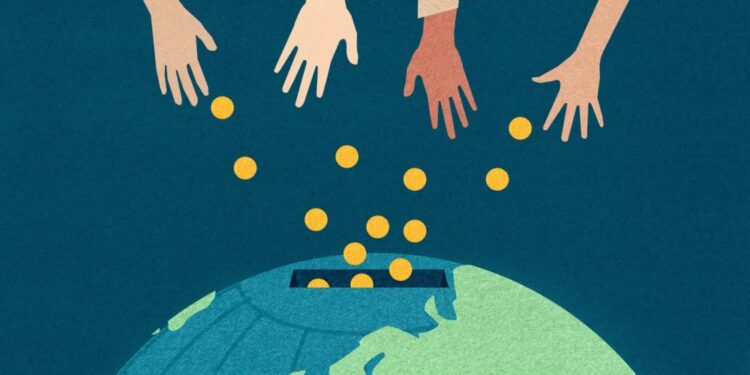Foreign aid in Africa has been a topic of significant global interest and debate for decades. It encompasses a wide range of financial, technical, and humanitarian assistance provided by foreign governments, international organizations, non-governmental organizations (NGOs), and philanthropic foundations to African countries. The main objectives of foreign aid in Africa are poverty reduction, economic development, improved healthcare, education, and infrastructure, as well as addressing issues like conflict resolution, human rights, and environmental sustainability. However, the effectiveness, impact, and controversies surrounding foreign aid in Africa have spurred complex discussions.
Historical context
Foreign aid to Africa has deep historical roots. Many African nations were colonized by European powers, and after gaining independence in the mid-20th century, they often maintained close ties with their former colonizers. This historical connection influenced aid relationships, with colonial powers often providing aid as a means of maintaining influence or addressing post-colonial responsibilities. During the Cold War, the United States and the Soviet Union used foreign aid as a geopolitical tool, backing African governments aligned with their respective ideologies.
Evolution of aid
Over the years, the focus of foreign aid in Africa has shifted. In the 1980s and 1990s, structural adjustment programs imposed by international financial institutions were prevalent, leading to mixed results. Critics argue that these programs often exacerbated poverty and inequality. Subsequently, there was a shift towards more targeted and results-oriented aid, with a focus on health, education, and infrastructure. Several phases of foreign aid can be identified:
a. The Early Years (1960s-1970s)
During this period, foreign aid to Africa primarily focused on infrastructure development, including roads, bridges, and dams. Major donors included former colonial powers, such as France and the United Kingdom, as well as the United States and international organizations like the World Bank and the United Nations.
b. The Structural Adjustment Era (1980s-1990s)
In response to economic crises and mounting debt in many African countries, international financial institutions introduced structural adjustment programs. These programs often required countries to implement austerity measures and market-oriented reforms in exchange for financial assistance. Critics argue that these policies led to increased poverty and inequality in some cases.
c. The New Millennium (2000s-present)
Aid to Africa evolved in the 21st century to address a broader range of development challenges, including healthcare, education, and governance. Initiatives like the United Nations’ Millennium Development Goals (MDGs) and later the Sustainable Development Goals (SDGs) set ambitious targets for improving living standards in Africa and other regions.
Types of foreign aid
Foreign aid to Africa can be categorized into several types.
1. Bilateral aid
Countries provide aid directly to African nations. For example, the United States provides bilateral aid to countries like Kenya for various development projects, including healthcare and education.
2. Multilateral aid
International organizations, such as the United Nations and the World Bank, pool resources from multiple countries and channel them to African nations. These organizations often have a broader development agenda. The World Bank, for instance, supports infrastructure projects across Africa.
3. Humanitarian aid
This form of aid is crucial during crises, such as natural disasters, conflicts, or pandemics. Organizations like Médecins Sans Frontières (Doctors Without Borders) provide medical assistance during health emergencies in African countries.
4. Development aid
Long-term aid focuses on sustainable development, including poverty alleviation, infrastructure development, and economic growth. Programs like the African Development Bank’s initiatives promote infrastructure projects like roads and energy facilities.
5. Technical assistance
This type of aid involves experts and knowledge transfer to build local capacity. For example, USAID might provide technical assistance to strengthen a country’s healthcare system.
Key players
Foreign aid in Africa involves a diverse range of stakeholders.
1. Bilateral aid
Major donor nations, including the United States, China, France, and the United Kingdom, engage in bilateral agreements with African countries. These agreements often reflect the respective donor’s unique priorities and interests. For example, China’s aid strategy frequently focuses on infrastructure development, while Western countries may emphasize democracy, human rights, and social development.
2. Multilateral aid
International organizations, such as the United Nations, World Bank, International Monetary Fund (IMF), and African Development Bank (AfDB), play pivotal roles in coordinating and disbursing aid. They provide expertise, set development goals, and ensure accountability, promoting a more harmonized and systematic approach to aid distribution.
3. Non-Governmental Organizations (NGOs)
A multitude of NGOs, such as Médecins Sans Frontières (Doctors Without Borders), Oxfam, and Save the Children, operate on the ground in Africa. These organizations focus on delivering healthcare, education, humanitarian assistance, and various other development initiatives.
Motivations for providing aid
Foreign aid to Africa is driven by a complex interplay of motivations.
1. Humanitarian reasons
Donors often provide aid to address pressing humanitarian crises, including poverty, hunger, and disease, with the ultimate goal of enhancing the quality of life for African populations.
2. Geopolitical interests
Major powers view Africa as a critical arena for securing geopolitical influence and access to valuable resources, such as oil, minerals, and agricultural products. This can result in aid packages that serve dual purposes – promoting development while advancing strategic interests.
3. Economic interests
Donor nations see Africa as an emerging market for their goods and services. By investing in African economies, they aim to create new trading partners and consumers for their products, potentially boosting their own economies in the process.
4. Security concerns
The stability of African nations is perceived as crucial for global security. Foreign aid is sometimes provided to address conflicts, extremism, and other security challenges that could have far-reaching implications beyond Africa’s borders.
Successes of foreign aid
Foreign aid in Africa has yielded numerous successes in various areas.
1. Healthcare and disease control
Foreign aid, particularly from organizations like the Global Fund to Fight AIDS, Tuberculosis, and Malaria, has played a crucial role in combating the HIV/AIDS epidemic in Africa. This aid has funded antiretroviral treatment programs, prevention efforts, and education campaigns, leading to a significant reduction in infection rates and improved treatment access. Aid has supported the distribution of insecticide-treated bed nets, the development of new treatments, and indoor residual spraying programs, resulting in a decline in malaria-related deaths in many African countries.
2. Education
Foreign aid has contributed to expanding access to education in Africa. Donor funding has supported the construction of schools, provision of textbooks, and teacher training, which has led to increased enrollment rates, particularly for girls. Aid has also provided scholarships and vocational training opportunities, enabling young Africans to acquire skills and pursue higher education.
3. Infrastructure
Investments have resulted in the construction of vital infrastructure such as roads, ports, energy facilities, and telecommunications networks, facilitating economic growth and connectivity. Aid-funded infrastructure projects, such as road construction and maintenance, have enhanced transportation networks in Africa, facilitating trade, economic growth, and access to remote areas. Aid has supported initiatives to provide clean water and sanitation facilities, reducing waterborne diseases and improving overall health.
4. Agriculture and food security
Foreign aid has promoted sustainable agriculture by providing farmers with training, seeds, and tools. These initiatives have increased crop yields, improved food security, and reduced hunger in many African regions. Aid has facilitated the development of infrastructure like roads and storage facilities, making it easier for farmers to access markets and sell their produce.
5. Debt relief
Initiatives like the Heavily Indebted Poor Countries (HIPC) initiative and the Multilateral Debt Relief Initiative (MDRI) have provided significant debt relief to African nations, freeing up resources for poverty reduction and development.
6. Humanitarian assistance
Foreign aid has been instrumental in providing emergency relief during natural disasters, conflicts, and health crises. Humanitarian organizations have delivered food, medical supplies, and shelter to those in need.
7. Conflict resolution and peacekeeping
Aid has supported peacekeeping missions and conflict resolution efforts in Africa, helping to stabilize regions affected by violence and civil strife.
8. Capacity building
Foreign aid has contributed to building the capacity of governments, civil society organizations, and institutions in Africa. This has helped improve governance, enhance public administration, and promote democratic processes.
9. Women’s empowerment and gender equality
Aid programs have focused on gender equality by supporting women’s economic empowerment, access to education, and participation in decision-making processes.
Challenges and criticisms
Despite its successes, foreign aid in Africa faces a range of persistent challenges and criticisms.
1. Corruption
Corruption in recipient countries can lead to misallocation of aid funds. Transparency International’s Corruption Perceptions Index highlights the prevalence of corruption in some African nations, which can undermine the impact of aid.
2. Lack of coordination
The multitude of donors often results in fragmented aid efforts, making it challenging for African governments to manage and prioritize projects effectively.
3. Debt burden
Some African countries have accumulated substantial debt from foreign loans, which can become a significant burden, jeopardizing their economic stability and future development prospects.
4. Aid dependency
The concept of aid dependency is a contentious issue. Some argue that Africa’s reliance on foreign aid impedes its development, while others contend that aid is a necessary lifeline for countries facing dire economic and humanitarian challenges. Striking a balance between aid and self-reliance is a recurring dilemma.
5. Ownership and conditionality
Foreign aid often comes with conditions attached, such as policy reforms or specific project implementation. While these conditions are intended to ensure accountability and alignment with donor objectives, they can sometimes clash with the recipient country’s priorities, raising questions about sovereignty.
Shifts in aid approaches
Recent years have witnessed changes in how aid is approached in Africa.
- Results-based approaches: Donors increasingly emphasize results and accountability, linking aid to measurable outcomes like poverty reduction and economic growth.
- Private sector development: Recognizing the importance of the private sector in driving economic growth, aid efforts now often involve fostering entrepreneurship and supporting small and medium-sized enterprises.
- Good governance: Efforts to combat corruption and promote good governance are integral to many aid programs. The African Union’s African Peer Review Mechanism is one example.
Future directions
The future of foreign aid in Africa will likely involve addressing these challenges and adapting to evolving circumstances.
1. Sustainable development
An emphasis on sustainable development practices is essential to reduce dependency on aid and foster economic self-sufficiency. This entails investing in renewable energy, environmentally friendly agriculture, and responsible resource management.
2. Transparency and accountability
Ensuring that aid funds are used effectively and transparently is crucial. Robust monitoring mechanisms, anti-corruption measures, and accountability structures should be in place to maintain trust between donors and recipients.
3. African-led solutions
Encouraging African nations to take the lead in their own development agendas is essential. This involves empowering local governments and institutions to identify their own priorities and implement projects aligned with their long-term goals.
4. Private sector engagement
Promoting partnerships with the private sector can stimulate economic growth, job creation, and innovation. Encouraging foreign direct investment (FDI) and supporting small and medium-sized enterprises (SMEs) can be key drivers of sustainable development.
Conclusion
Foreign aid in Africa is a multifaceted and evolving endeavor, shaped by historical legacies, geopolitical interests, and complex motivations. To maximize its impact, it is crucial for donors, recipient nations, and international organizations to collaborate in a coordinated and sustainable manner, ensuring that aid contributes to the long-term development and well-being of the African continent while addressing issues of governance, corruption, and dependency. The road ahead will require adaptability, innovation, and a commitment to inclusive and sustainable development in Africa.















